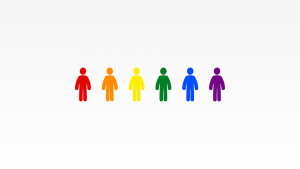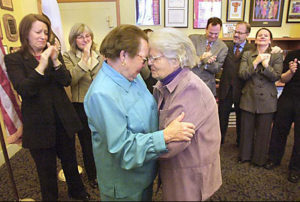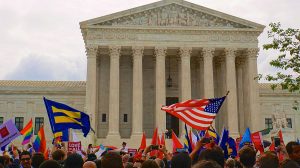6.9: Civil Rights Case Study--Sexual Orientation
- Page ID
- 134596
“You can have as many debates about gay marriage as you want, and over the last 22 years of campaigning for it, I’ve had my share. You can debate theology, and the divide between church and state, the issue of procreation, the red herring of polygamy, and on and on. But what it all really comes down to is the primary institution of love. The small percentage of people who are gay or lesbian were born, as all humans are, with the capacity to love and the need to be loved. These things, above everything, are what make life worth living. And unlike every other minority, almost all of us grew up among and part of the majority, in families where the highest form of that love was between our parents in marriage. To feel you will never know that, never feel that, is to experience a deep psychic wound that takes years to recover from.”
—Andrew Sullivan in 2011 (1)
Background and Historical Development of Homosexuality as an Identity

Homosexual behavior is as old as human civilization and is evident across both tolerant and intolerant societies. Throughout U.S. history, many homosexuals repressed or hid their identities from their families, their employers, and from themselves. For those who embraced their sexual orientation, it was important for them to meet and develop relationships with other gay men and women. By the 1910s and 1920s, gay and lesbian bars, bathhouses, cafés, restaurants, and music halls were flourishing in most large American cities such as New York, Chicago, Boston, San Francisco, St. Louis, and Los Angeles. Other homosexuals formed private social clubs or cruised notorious pick-up areas in major cities. They faced prosecution, social ostracism, and employment discrimination if they were caught. (4)
The Early Gay Rights Movement
The Society for Human Rights, formed by Henry Gerber (1892-1972) in Chicago in 1924, was the first gay rights group in America. The Society set out to publish a journal and make connections with European gay rights groups, but its leaders were quickly arrested and prosecuted by Chicago police. The cost of defending himself at three separate trials bankrupted Henry Gerber, even though the charges were ultimately dismissed. He lost his job at the Postal Service, and the Society didn’t survive. In New York, the Veterans Benevolent Association formed in 1945 and attempted to secure G. I. Bill benefits for homosexual veterans who had been dishonorably discharged. It did not succeed. (9)
Persecution of homosexuals ramped up during the McCarthy period—i.e., late 1940s and the 1950s—as the federal government looked for national security risks by investigating the private lives of its employees. Between 1950 and 1953, between 40 and 60 homosexuals a month were driven out of their government positions. (10) State and local governments persecuted homosexuals as well by continually raiding gay establishments and hangouts, prosecuting people either for being gay or for homosexual behavior and removing homosexuals from government positions.
IFor example, in 1957 Frank Kameny was fired from his government position with the Army Map Service because he was gay. His case because the first civil rights case on the issue of sexual orientation to reach the Supreme Court. He lost, but did not give up the fight. In 1965, he organized the first gay rights demonstration in front of the White House. However, it was not until 2009 that he received a formal apology from the U.S. government for his unjust dismissal from federal service.

The modern gay rights movement was born in the midst of this persecution. In 1947 under the pseudonym Lisa Ben, Edythe Eyde wrote Vice Versa: America’s Gayest Magazine, America’s first regular homosexual publication. (11) Founded in 1951 by Harry Hay, the Mattachine Society was dedicated to changing the public’s mind about the “deviancy” of homosexuals. The Society published a magazine called One, which was initially banned by the Post Office. In 1958, the Supreme Court ruled that the ban violated the Mattachine Society’s first amendment rights. By the 1970s more militant groups took over, and the society finally disbanded in 1987. The first postwar lesbian organization was the Daughters of Bilitis, founded in 1955 in San Francisco by Del Martin and Phyllis Lyon. It, too, created a magazine--The Ladder.
From Compton’s Cafeteria to Don’t Ask Don’t Tell
Perhaps, the most well-known event in the history of the U.S. gay liberation movement is the Stonewall Rebellion. The Stonewall Inn was a gay bar in the Greenwich Village section of New York City. Eight police officers raided the establishment after midnight on June 28, 1969. On that night the police met considerable resistance from Stonewall patrons and others in the neighborhood. More police arrived, beating protesters—who, in turn, were throwing bottles and rocks. Eventually, hundreds of police officers were battling a couple thousand protesters. The rioting lasted three nights. This rebellion was the first time that large numbers of homosexuals resisted police action, and it energized an already-forming nationwide revitalization of the gay-liberation movement. Activists founded new groups such as the Gay Liberation Front and the Gay Activists Alliance, and employed traditional political tactics such as marches, demonstrations, strikes, boycotts, lobbying, campaigning, and fund-raising.
Aside from making political demands to decriminalize and end discrimination against homosexuality, gay rights groups targeted the medical establishment’s century-old stance that homosexuality was an illness. That line became untenable as research into the nature of homosexuality increasingly suggested that problems suffered by gays and lesbians were less a result of their sexual orientation and more a result of homophobia, discrimination, alienation from families, and social marginalization. The National Association of Mental Health passed a resolution in 1970 calling to decriminalize homosexuality. In 1972, the National Association of Social Workers decided to reject the notion that homosexuality was an illness. By 1975, both the American Psychological Association and the American Psychiatric Association had voted to remove homosexuality from their lists of pathologies.
The 1970s and 80s also saw changes in the political sphere. In 1974, Elaine Noble became the first openly lesbian woman elected to public office. She won a seat in the Massachusetts state House of Representatives. In an interview, Noble said that her first campaign was “ugly,” with gunshots through her windows and, people visiting her house and campaign office were harassed. Once, while in office, feces were left on her desk. She won re-election in 1976. (14)
In 1978, Harvey Milk took office as the first openly gay man elected to public office, having been elected in November of 1977 to be on the San Francisco Board of Supervisors. Ten days after the election he recorded three tapes that he gave to friends and his lawyer, to be listened to in the event of his assassination. He said, “I fully realize that a person who stands for what I stand for—a gay activist—becomes the target or potential target for a person who is insecure, terrified, afraid, or very disturbed themselves.” He sponsored a bill banning discrimination in San Francisco on the basis of sexual orientation, and Mayor George Moscone signed it into law. On November 27, 1978, Dan White, a former member of the Board of Supervisors who had recently resigned his position and then asked to be reinstated, assassinated Mayor Moscone and Harvey Milk with a .38 revolver. (15)
In 1994, President Bill Clinton’s administration instituted a Don’t Ask, Don’t Tell policy in the U.S. military. This policy essentially allowed homosexual men and women to serve in the military as long as they remained closeted—which was the don’t tell part of the policy. The military would not actively look for gays and lesbians in the ranks—the don’t ask part of the policy. However, it would not tolerate them if they were discovered. In 2010, Democrats in the House of Representatives amended the Defense Authorization Act to end Don’t Ask, Don’t Tell and allow gays and lesbians to serve openly in the military, but Republicans led by Senator John McCain successfully filibustered it in the Senate. Later that year, a standalone bill ending Don’t Ask, Don’t Tell finally passed both chambers and was signed by President Barack Obama.
Marriage Equality and the Equality Act
A high-profile issue with respect to the gay liberation movement was marriage equality. The marriage equality issue came to a legal battle pitting civil rights leaders against two prominent attempts to stop the cultural shift in favor of marriage equality: The Defense of Marriage Act and California’s Proposition 8.
In 1996, Congress passed the Defense of Marriage Act (DOMA), which defined marriage for federal purposes to exclude same-sex marriage and also permitted states to refuse to recognize same-sex marriages performed in other states. At the time, no state allowed same-sex marriages, but it became legal in some places either as a result of court decisions or changes in state law. Challenges to DOMA and California’s Proposition 8 worked their way up to the Supreme Court, and in 2013, the Supreme Court issued rulings on both.
In United States v. Windsor (2013), the Court invalidated those portions of DOMA that denied federal benefits to same-sex marriage partners. The Defense of Marriage Act’s provisions regarding the federal definition were declared unconstitutional.
In 2009, California’s Proposition 8 amended the California state constitution to forbid gay marriage. In 2010, a federal district court ruled that Proposition 8 was an unconstitutional violation of the Fourteenth Amendment’s due process and equal protection clauses. The state of California refused to participate in the appeal and the case–Hollingsworth v. Perry (2013)—was appealed to the Supreme Court by the original private proponents of Proposition 8. However, the Court ruled on technical grounds that the private proponents of Prop 8 did not have the standing to bring the appeal. That decision left in place the lower federal court’s ruling that Prop 8 is unconstitutional. Both Hollingsworth v. Perry (2013) and United States v. Windsor (2013) were decided by narrow 5-4 decisions.

The legal fallout from the Windsor case was swift. In Utah, a federal judge named Robert Shelby struck down a state referendum that had defined marriage as one man and one woman, writing, “Applying the law as it is required to do, the court holds that Utah’s prohibition on same-sex marriage conflicts with the United States Constitution’s guarantees of equal protection and due process under the law. The State’s current laws deny its gay and lesbian citizens their fundamental right to marry and, in so doing, demean the dignity of these same-sex couples for no rational reason. Accordingly, the court finds that these laws are unconstitutional.” (18)
A test case arose almost immediately. James Obergefell and John Arthur married in Maryland right after the Windsor case was decided, and then sued the state of Ohio, their state of residence, when it refused to recognize their union. By the time the case reached the Supreme Court in 2015, it had been joined with three other similar cases from different jurisdictions around the country. The Court ruled 5-4 in Obergefell v. Hodges (2015) that state prohibitions against same-sex marriages were unconstitutional, as was the portion of the Defense of Marriage Act that allowed states to refuse to recognize gay marriages performed in other states.
In 2020, the Supreme Court ruled that the 1964 Civil Rights Act’s prohibition of workplace discrimination based on “sex” covered discrimination against members of the LGBTQ. (21)
In 2021, Democrats in the U.S. House of Representatives passed the Equality Act, which “prohibits discrimination based on sex, sexual orientation, and gender identity in areas including public accommodations and facilities, education, federal funding, employment, housing, credit, and the jury system. Specifically, the bill defines and includes sex, sexual orientation, and gender identity among the prohibited categories of discrimination or segregation.” (19) The bill was not voted on by the Senate.
References
1. Andrew Sullivan, “Why Gay Marriage is Good for America,” Newsweek. July 18, 2011.
2. John D’Emilio, Making Trouble. Essays on Gay History, Politics, and the University. New York: Routledge, 1992. Page 8.
3. Michael Bronski, A Queer History of the United States. Boston: Beacon Press, 2011. Chapter 1.
4. Aside from the sources already cited in notes 2 and 3, see also John D’Emilio and Estelle B. Freedman, Intimate Matters: A History of Sexuality in America. Third Edition. Chicago: The University of Chicago Press, 2012.
5. Barry D. Adam, The Rise of a Gay and Lesbian Movement. Revised edition. London: Twayne Publishers, 1995. Page 35.
6. Author’s translation of Paragraph 175 as displayed by the United States Holocause Memorial Museum.
7. Magnus Hirschfeld, Die Homosexualitat des Mannes and des Weibes. Originally published in 1914. Translated by Michael A. Lombardi-Nash and published by Prometheus Books in 2000. Page 544. Available here.
8. No Author, “Persecution of Homosexuals,” United States Holocaust Memorial Museum. No date.
9. Lillian Faderman, The Gay Revolution. The Story of the Struggle. New York: Simon & Schuster, 2015. Page 55.
10. John D’Emilio, Sexual Politics, Sexual Communities. Chicago: University of Chicago Press, 1983. Pages 41-44.
11. Bronski, Queer History, 176.
12. Adam, The Rise of a Gay and Lesbian Movement, 68.
13. Sam Levin, “Compton’s Cafeteria Riot: A Historic Act of Trans Resistance, Three Years Before Stonewall,” The Guardian. June 21, 2019.
14. Elaine Noble interviewed for Out and Elected in the USA. Archived here.
15. Lillian Faderman, Harvey Milk. His Lives and Death. New Haven: Yale University Press, 2018.
17. Adam Liptak, “Supreme Court Bolsters Gay Marriage With Two Major Rulings,” The New York Times. June 26, 2013.
18. Kitchen, et al. v. Herbert, et al. (2013)
19. Equality Act.
20. Michelle Garcia, “Equality Act Passed the House. Here’s What Happens Next,” Out. May 17, 2019.
21. Bostock v. Clayton County, Georgia (2020).
Media Attributions
- Gay Symbol © Pixabay is licensed under a CC0 (Creative Commons Zero) license
- Martin Lyon Marriage © Olga Berrios is licensed under a CC BY (Attribution) license
- Obergefell © Ted Eytan is licensed under a CC BY-SA (Attribution ShareAlike) license

